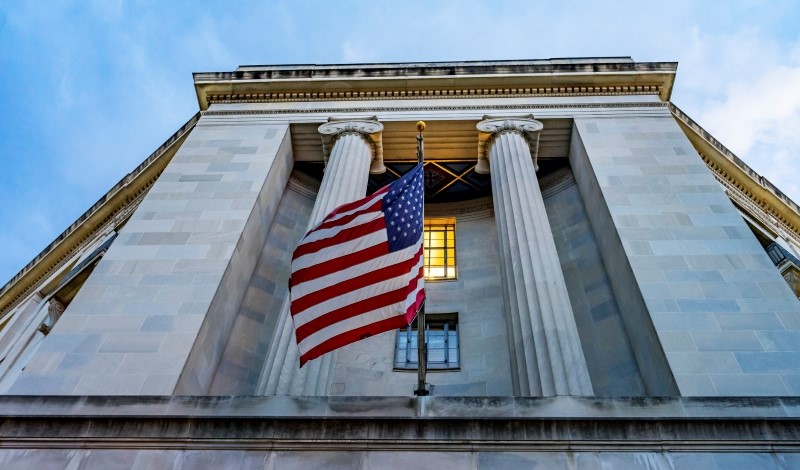
The Justice Department and the FTC jointly release final antitrust policy for business mergers.
Today, many consumers confront high drug prices set by major pharmaceutical companies. Tech giants, such as Google and Meta, seem to dominate the internet. And one in nine employees are covered by noncompete agreements that prevent them from working for competitors.
Although these are highly varied public concerns, the Biden Administration blames the concerns, in part, on lax enforcement of the federal antitrust laws. To strengthen antitrust oversight across the economy, the U.S. Department of Justice and the Federal Trade Commission (FTC) released new Merger Guidelines last December to reflect their joint position on merger enforcement policy.
The Justice Department and the FTC together maintain responsibility for investigating and punishing firm conduct that monopolizes markets and joint conduct that restrains trade when firms have sufficient market power. Under the federal antitrust laws, they also scrutinize proposed mergers.
The Merger Guidelines consist of principles and frameworks that reflect the government’s approach to merger enforcement and inform the public of its priorities.
In certain circumstances, such as when a proposed merger reaches a specified monetary threshold, the companies that plan to merge must notify the Justice Department and the FTC. The agencies use the Merger Guidelines as a nonbinding tool to analyze transactions and determine whether to investigate the merger’s potential effects.
The new Merger Guidelines list 11 general guidelines, six of which are frameworks used to “assess whether a merger may substantially lessen competition or tend to create a monopoly,” and five of which express how to apply the frameworks in certain settings.
One guideline, for example, asserts that the Justice Department and FTC will consider in their analysis whether a merger will eliminate “substantial competition” between merging companies. Another guideline states that the government will consider whether the merger may prevent another firm from entering a concentrated market at all.
Merging parties can present evidence to rebut the government’s presumption that a merger will be harmful. The new Guidelines contain a section describing what types of evidence companies may present to do so, including evidence of procompetitive benefits of a merger or evidence that one of the merging parties would cease to exist absent the transaction. The Guidelines also include a section of “analytical, economic, and evidentiary tools” used in the government’s analysis of mergers.
Since 1968, the Justice Department and the FTC have jointly issued guidelines to reflect the government’s evolving position on merger enforcement. Although not every new presidential administration issues updated guidelines, each new set of guidelines tends to account for economic, market, legal, and social changes that occur between updates.
In 2021, President Biden issued an executive order warning that industries across the country have become more concentrated. He argued that the concentration has denied consumers and workers the opportunity to participate in an open economy and has led to increased inequality, weaker bargaining power for workers, higher prices, and lower quality goods and services. He encouraged the Justice Department and the FTC to exercise greater antitrust scrutiny.
Leaders at the Justice Department and FTC responded not only by bringing novel legal challenges against mergers, but also by initiating an update to previous Guidelines to reflect “modern market realities, advances in economics and law, and the lived experiences of a diverse array of market participants.”
In July 2023, the Justice Department and the FTC released a draft version of the Merger Guidelines for public comment. The draft garnered widespread attention, receiving over 30,000 comments and serving as the subject of numerous op-eds in major national newspapers.
Some commenters on the draft Guidelines expressed concern about the federal government’s reliance on outdated Supreme Court precedent to support its policy changes. Commenters also argued that the agencies focused too much on increased concentration without sufficient focus on whether concentration had harmful effects.
The final Guidelines reflect consideration of these strong initial reactions, limiting reliance on old case law and tamping down certain language.
Nonetheless, experts acknowledge that the new Guidelines are more aggressive than previous versions. For example, the 2023 Guidelines specifically highlight circumstances that past guidelines did not focus on, such as serial acquisitions, potential competition, and multisided platforms.
The new Guidelines also set market share and concentration standards that are lower than the 2010 Guidelines, which will allow the government to challenge a wider universe of mergers.
Fiona Scott Morton, professor at Yale University School of Management, praised the changes, asserting that they “promise to bring the economic analysis of merger enforcement in the United States up to date” and will more effectively prevent harmful mergers.
Opponents of the changes raise concerns about the impact the new Guidelines will have on future business transactions. The president of the Computer and Communications Industry Association, Matt Schruers, suggested that the new merger guidelines “may risk chilling valuable transactions in ways that would weaken U.S. exporters’ ability to compete globally.”
But Michael Kades, a Justice Department official, argued that the guidelines could have gone even further, characterizing them as “arguably conservative.”
Because the Guidelines are not binding, both supporters and opponents will have to wait to see whether or not courts adopt the agencies’ latest principles on prospective mergers.



